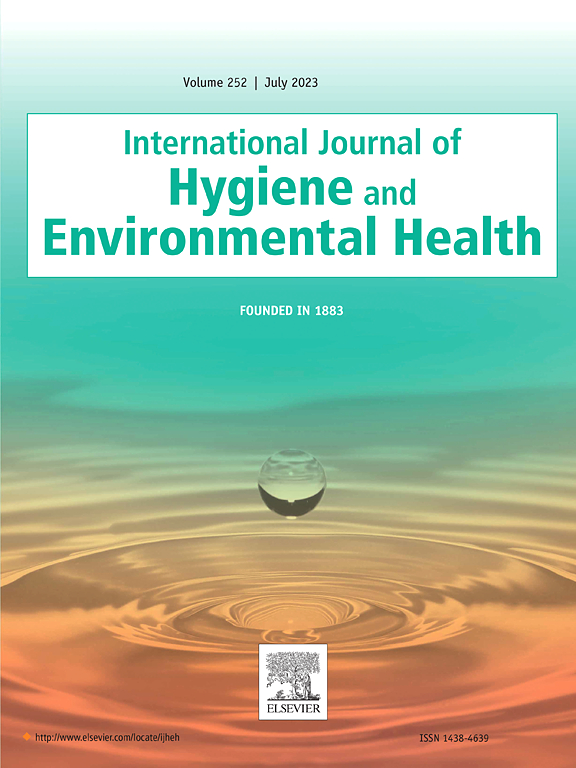Environmental surveillance for Salmonella Typhi to detect the typhoid burden in Yogyakarta, Indonesia
IF 4.4
2区 医学
Q1 INFECTIOUS DISEASES
International journal of hygiene and environmental health
Pub Date : 2025-03-30
DOI:10.1016/j.ijheh.2025.114572
引用次数: 0
Abstract
Background
In low and middle-income countries (LMICs), understanding the burden of typhoid disease has been challenging as clinical surveillance based on blood culture data alone often poorly represents the community burden. Underreported cases, unclear case definitions, the presence of a chronic carrier state and emerging antimicrobial resistance necessitate alternative approaches to assess disease prevalence and target public health interventions, such as vaccine introduction. This study aimed to assess the feasibility of wastewater and environmental surveillance (WES) in measuring the prevalence of typhoid infection in Indonesia.
Methods
Between October 11, 2022, and August 31, 2023, WES was conducted in 18 locations across 3 districts in Yogyakarta province, Indonesia. Samples were collected fortnightly from wastewater treatment plants (WWTPs), manholes, a river, and public spaces, using grab and passive sampling methods. Salmonella Typhi (S. Typhi) detection was conducted using quantitative PCR for S. Typhi genes (ttr, tviB, and staG – all positive).
Results
Of the 406 samples collected, 13 % (51/406) tested positive for S. Typhi, with monthly positivity rates ranging from 2 % (1/51) in March 2023 to 47 % (16/34) in October 2022. Mean concentrations (in log10) in ttr, tviB, and staG in grab samples were 0.67 (SD ± 0.99), 0.23 (SD ± 1.14), and −0.11 (SD ± 1.05). The highest detection rates were observed in samples from the river compared to central WWTPs (OR 12.68; 95 % CI 2.03–79.20, P = 0.007). No correlation was observed between rainfall and S. Typhi gene detection (P > 0.05 for all genes).
Conclusion
WES is feasible in Indonesia and can be used to monitor typhoid disease burden in an endemic region. High positivity rates from the river and septic tanks in traditional markets support a broad approach to sampling in LMICs where formal wastewater management systems may not accurately represent community disease prevalence due to its low population coverage. WES can be a valuable tool to inform public health responses, including vaccine introduction.
印度尼西亚日惹市伤寒沙门氏菌环境监测以检测伤寒负担
在低收入和中等收入国家(LMICs),了解伤寒疾病的负担一直具有挑战性,因为仅基于血培养数据的临床监测往往不能很好地代表社区负担。由于病例报告不足、病例定义不明确、存在慢性带菌者状态以及正在出现的抗菌素耐药性,需要采用替代方法来评估疾病流行情况和有针对性的公共卫生干预措施,例如引入疫苗。本研究旨在评估废水和环境监测(WES)在印度尼西亚测量伤寒感染流行的可行性。方法于2022年10月11日至2023年8月31日在印度尼西亚日惹省3个地区的18个地点进行WES调查。采用抓取法和被动采样法,每两周从污水处理厂、沙井、河流和公共场所采集样本。采用定量PCR法检测伤寒沙门氏菌基因(ttr、tviB和staG - all阳性)。结果406份样本中,13%(51/406)呈伤寒沙门氏菌阳性,月阳性率从2023年3月的2%(1/51)到2022年10月的47%(16/34)不等。样品中ttr、tviB和staG的平均浓度(log10)分别为0.67 (SD±0.99)、0.23 (SD±1.14)和- 0.11 (SD±1.05)。与中央污水处理厂相比,河流样本的检出率最高(OR 12.68;95% ci 2.03-79.20, p = 0.007)。降雨量与伤寒沙门氏菌基因检测无相关性(P >;所有基因0.05)。结论wes在印度尼西亚是可行的,可用于伤寒流行地区的疾病负担监测。传统市场中河流和化粪池的高阳性率支持在中低收入国家采用广泛的抽样方法,这些国家由于人口覆盖率低,正规的废水管理系统可能无法准确代表社区疾病流行情况。WES可成为告知公共卫生应对措施(包括疫苗引进)的宝贵工具。
本文章由计算机程序翻译,如有差异,请以英文原文为准。
求助全文
约1分钟内获得全文
求助全文
来源期刊
CiteScore
11.50
自引率
5.00%
发文量
151
审稿时长
22 days
期刊介绍:
The International Journal of Hygiene and Environmental Health serves as a multidisciplinary forum for original reports on exposure assessment and the reactions to and consequences of human exposure to the biological, chemical, and physical environment. Research reports, short communications, reviews, scientific comments, technical notes, and editorials will be peer-reviewed before acceptance for publication. Priority will be given to articles on epidemiological aspects of environmental toxicology, health risk assessments, susceptible (sub) populations, sanitation and clean water, human biomonitoring, environmental medicine, and public health aspects of exposure-related outcomes.

 求助内容:
求助内容: 应助结果提醒方式:
应助结果提醒方式:


